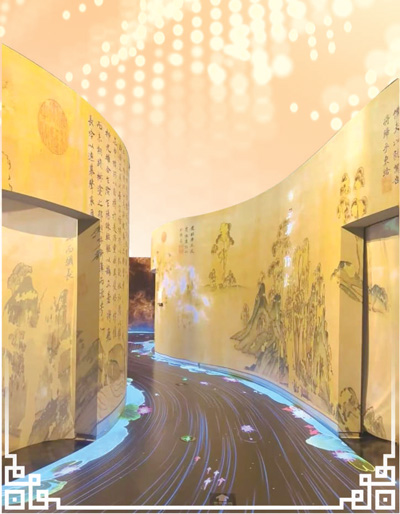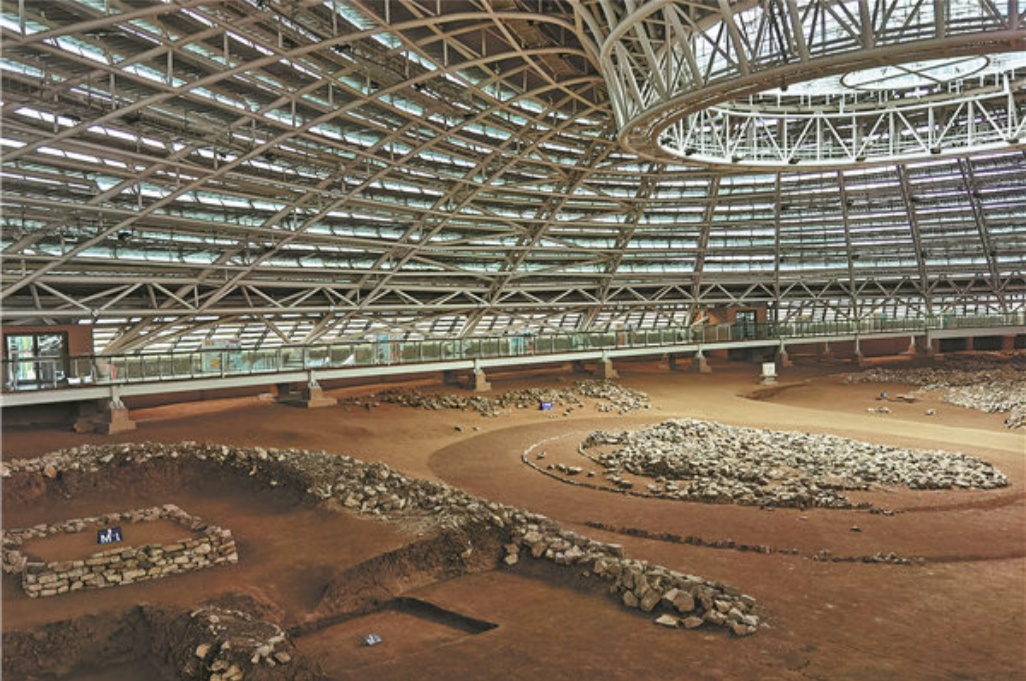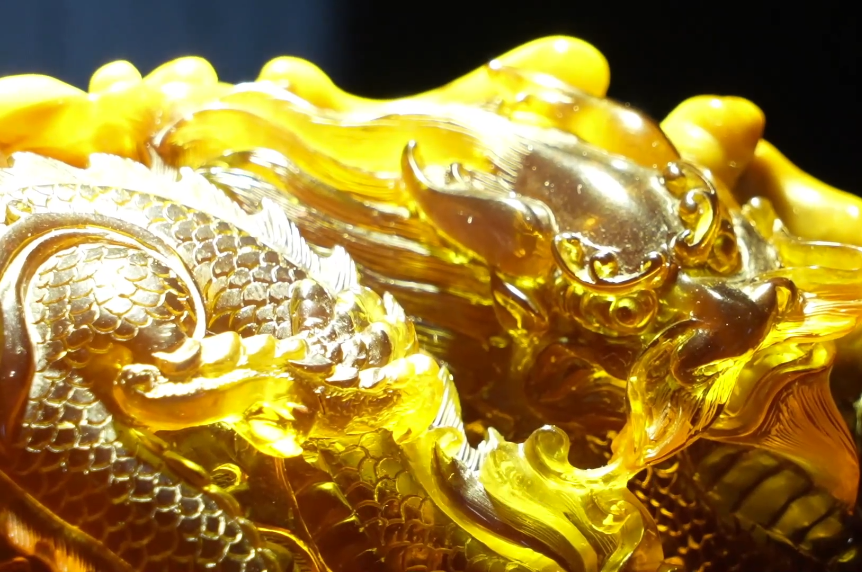Alongside the bank of the Luohe River, a fairy maiden with her hair combed high in a bun walks gracefully over the water, with her sleeves fluttering in the gentle breeze... This marvellous scene is not a product in a 3D cinema, but belongs to the immersive digital exhibition “Splendor of Tang and Song Dynasties—Art World in Digital Paintings” (hereinafter referred to as “Tang and Song Splendor”) launched at the Liaoning Provincial Museum.
Empowered by digital technology, the Liaoning Provincial Museum has been innovating its exhibitions in form, allowing visitors to engage with ancient calligraphic and painting works firsthand, and immersively comprehend the profound cultural connotations behind the cultural relics.

In the “Luohe Beauty” area of “Tang and Song Splendor”, visitors can recline on sofas, and gaze upward at the dome, to immerse themselves in the digital realm of the ancient painting Nymph of the Luohe River.
The original work of Nymph of the Luohe River is said to be drawn by Gu Kaizhi of the Eastern Jin Dynasty, but has been lost. The replica presently exhibited at the museum dates back to the Song Dynasty. Dong Baohou, deputy curator of the Liaoning Provincial Museum, stated, “We extracted details from Nymph of the Luohe River, and renarrated the story of Cao Zhi and the nymph from their encounter to separation. As the dome screen unfolds the story in vivid detail, visitors can fully immerse themselves in this story.”
Nymph of the Luohe River is just one of the highlights. VR glasses transport visitors to a visual realm where they can transform into white cranes to soar through Bianjing (the capital of the Northern Song Dynasty) during the Lantern Festival, and relish the sight of auspicious cranes traversing through colorful clouds over the Xuande Gate. “It’s remarkable to witness the mountains and rivers of the Song Dynasty!” exclaimed a visitor to the site.
The Liaoning Provincial Museum has selected six paintings of the Tang and Song dynasties from its collections, including Nymph of the Luohe River, Lady of Guoguo on a Spring Outing, Reading Yi Jing by Autumn Window, Court Ladies Adorning Their Hair with Flowers, Waiting for Ferry in Summer Mountains, and Auspicious Cranes, to create a visual wonder for visitors through an ultra-high-definition, immersive digital space.
Dong introduced, “Via technologies such as holographic projection, virtual reality, augmented reality and interactive games, the exhibition not only restores the beauty of the original works, but also reproduces the grand view of the dynasties, providing visitors with a journey through time and space.” The exhibition boasts ten areas, including the animation display area of Nymph of the Luohe River, “Luohe Beauty”, “Silk Clothing in Late Spring”, “Reading Yi Jing by Autumn Window”, and “Pretty Face and Flowing Skirt”.
“The immersive experiences have greatly enhanced visitors’ sense of participation and involvement. They make history and culture more vivid and understandable, allowing visitors to feel the charm of the integration of traditional art and modern technology,” added Dong.
Cultural relics also require “dormancy”. “For better conservation, each cultural relic in the museum enters a ‘dormant period’ accordingly, and is exhibited for only three months every three years,” Dong explained.
Thus, how should cultural relics conservation and visitors’ needs be balanced? Digital applications offer new insights into curation.
Against distant lush mountains, red maples and green pines add to each other’s beauty inside and outside a courtyard by a river. Within the study, a man is sitting alone and reading by a window, accompanied by a boy servant standing outside the door... In the animation display area of Reading Yi Jing by Autumn Window, the main screen and ambient gauze curtains showcase the scenes of the original painting in multiple layers.
Through the digital exhibition, visitors can obtain more information about the cultural relics, and learn more stories behind them. “This is a small painting created by Liu Songnian, a court painter of the Southern Song Dynasty. Through digital presentation, visitors can clearly see many details of it, such as the composition and drawing techniques, which are difficult to exhibit in traditional exhibitions.” Dong said. The painting is presented in a new dynamic format, with the changing light and shadow manifesting its charm and artistic appeal.
The digital application of “enjoying paintings + interactive experience” has enhanced the interactivity of the exhibition. In the “Lantern Festival” section of “Fairy Birds Send Auspiciousness”, visitors can participate in diverse ancient-style interactive games, such as piying (shadow puppetry), datiehua (striking iron flowers), guessing lantern riddles, and releasing flower lanterns, through the linkage between their mobile phones and the exhibition hall screens. In the “Rainbow-Colored and Feathered Costumes” section, visitors can personally paint clothes for the ancient people... Behind the cultural relics lies endless cultural beauty, which is definitely worth exploring and savoring.
Exhibiting the cultural relics across China has always been Dong’s cherished desire. “By means of digital presentation methods and digital exhibition halls, we can tour the exhibition in major museums across the country, allowing visitors to locally appreciate the precious collections of the Liaoning Provincial Museum,” said Dong.
In recent years, the Liaoning Provincial Museum has been constantly exploring digital transformation both online and offline, to “enliven” and “revitalize” its cultural relics.
At the “Blue and White Lingering Charm—Exhibition of Blue and White Porcelain from Yuan Dynasty” stands a three-dimensional digital display device. Visitors only need to tap the touch screen to view and admire the blue and white porcelain wares of the Yuan Dynasty collected in other museums. Through this interactive screen, they can not only look up the origins and history of the artifacts, but also observe their details by flipping them 360 degrees and zooming them in or out on screen.
In the “Harmony and Unity in China” special exhibition, visitors can also step into a digital space and engage with cultural relics closely. The dynamic Looking Far on Small Boat is being displayed on a large digital screen: a boatman gently paddles his boat near the bank; an old man with a white beard sits steadily on the boat. As the oar is pulled, the entire boat leaps to the eyes. Visitors can fully indulge themselves in the scene.
“From the digital processing of parts of the exhibition hall or certain cultural relic to the current digital panoramic display of ‘Tang and Song Splendor’, the Liaoning Provincial Museum has realized the transition from exhibition digitization to digital exhibitions.” Dong remarked. Visitors can feel the historical value behind the cultural relics firsthand, whether in bustling streets or poetic landscapes, building up reverence for history and passion for culture.
“The digital exhibition has created a dialogue scene between visitors and history. The integration of culture and technology has also opened up broad prospects for high-quality development in the field of culture and museums,” said Wang Xiaowen, curator of the Liaoning Provincial Museum.






